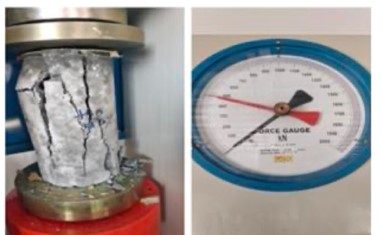Pengaruh Fly Ash Terhadap Kuat Tekan dan Porositas Beton Berpori
The Effect of Fly Ash on the Compressive Strength and Porosity of Porous Concrete
DOI:
https://doi.org/10.25299/saintis.2020.vol20(02).5622Keywords:
beton berpori, fly ash, kuat tekan, porositasAbstract
[ID] Peningkatan penggunaan beton konvensional mengakibatkan lapisan kedap air semakin luas, yang berimbas kepada turunnya muka air tanah dan terjadi banjir pada musim hujan. Hal ini dapat disiasati salah satunya melalui pengaplikasian cara-cara pembangunan yang ramah lingkungan, seperti penggunaan fly ash. Tujuan penelitian kali ini adalah untuk mengetahui presentase fly ash pada campuran beton agar menghasilkan kuat tekan dan porositas optimum. Pada penelitian ini digunakan fly ash sebagai bahan tambahan campuran dengan variasi sebesar 0%, 10%, dan 20% dari berat semen dan variasi faktor air semen (FAS) yang digunakan sebesar 0,3 , 0,4 , 0,5. Agregat kasar berukuran maksimum 20 mm, dengan jumlah sampel 36 buah silinder, 27 buah silinder untuk pengujian kuat tekan dan 9 buah silinder untuk pengujian porositas dilakukan pada usia 28 hari. Mutu beton rencana pada penelitian ini 10 MPa mengacu pada mutu bata beton. Pengujian kuat tekan beton yang dihasilkan menggunakan alat CTM (Compression Testing Machine) dan pengujian porositas menggunakan alat Falling Head Water Permeability Test yang megacu pada ACI 522R-10 yang dimodifikasi. Hasil ekperimen menunjukan nilai optimum kuat tekan dan porositas rata-rata dengan variasi FAS 0,3 : FA 10%, untuk umur beton 28 hari secara berturut-turut adalah 5,4 MPa dan 7,75 m3/s. Kesimpulan penelitian ini adalah komposisi paling optimum untuk penggunaan fly ash yaitu sebesar 10% dengan faktor air semen 0,3.
[EN] The increase in the use of conventional concrete resulted in a wider airtight layer, which resulted in the lowering of the groundwater level and flooding during the rainy season. One of the ways to overcome this is through the application of environmentally friendly development methods, such as the use of fly ash. The purpose of this research was to determine the percentage of fly ash ih concrete mixture to produce optimum compressive strength and porosity. In this study, fly ash was used as an additional mixture with variations of 0%, 10%, and 20% of the weight of cement and variations of the cement water factor (FAS) used were 0.3, 0.4, 0.5. The maximum size of coarse aggregate is 20 mm, with a sample size of 36 cylinders, 27 cylinders for compressive strength testing and 9 cylinders for porosity testing carried out at the age of 28 days. The quality of the concrete plan in this study is 10 MPa which refers to the quality of the concrete brick. Testing the compressive strength of the concrete produced using a CTM (Compression Testing Machine) and porosity testing using the Falling Head Water Permeability Test which refers to the ACI 522R-10. The experimental results showed that the optimum compressive strength and average porosity with FAS variation of 0.3: FA 10%, for 28 days of concrete were 5.4 MPa and 7.75 m3
Downloads
References
N. U. Kockal and T. Ozturan, “Effects of lightweight fly ash aggregate properties on the behavior of lightweight concretes,” J. Hazard. Mater., vol. 179, no. 1–3, pp. 954–965, 2010, doi: 10.1016/j.jhazmat.2010.03.098.
NRMCA, “Concrete in Practice CIP-38 Pervious Concrete,” 2004.
M. Franus, J. Panek Rafałand Madej, and W. Franus, “The properties of fly ash derived lightweight aggregates obtained using microwave radiation,” Constr. Build. Mater., vol. 227, pp. 1–10, 2019, doi: 10.1016/j.conbuildmat.2019.116677.
ASTM C150 / C150M - 20, “Standard Specification for Portland Cement,” ASTM International, West Conshohocken, PA, 2020, www.astm.org.
ASTM C125-20, “Standard Terminology Relating to Concrete and Concrete Aggregates,” ASTM International, West Conshohocken, PA, 2020, www.astm.org.
ASTM C33 / C33M - 18, “Standard Specification for Concrete Aggregates,” ASTM International, West Conshohocken, PA, 2018, www.astm.org.
J. O. Slmanjuntak, T. E. Saragi, F. H. Simbolon, K. Sirlngo-ringo, J. P. Sltanggang, and P. L. L. Sianturi, “Hubungan Perawatan Beton dengan Kuat Tekanan (Pengujian Laboratorium),” J. Poliprofesi, vol. X, no. 1, July, 2015.
ASTM C188-17, “Standard Test Method for Density of Hydraulic Cement,” ASTM International, West Conshohocken, PA, 2017, www.astm.org.
ASTM C566-19, “Standard Test Method for Total Evaporable Moisture Content of Aggregate by Drying,” ASTM International, West Conshohocken, PA, 2019, www.astm.org.
ASTM C127-15, “Standard Test Method for Density, Relative Density (Specific Gravity), and Absorption of Coarse Aggregate,” ASTM International, West Conshohocken, PA, 2015, www.astm.org.
ASTM C136 / C136M - 19, “Standard Test Method for Sieve Analysis of Fine and Coarse Aggregates,” ASTM International, West Conshohocken, PA, 2019, www.astm.org.
ASTM C29/C29M – 17a, “Standard Test Method for Bulk Density (‘Unit Weight’) and Voids in Aggregate, Manual of Aggregate amd Concrete Testing,” ASTM International, West Conshohocken, PA, 2020, www.astm.org.
Badan Standardisasi Nasional, SNI 2847 : 2013 Persyaratan Beton Struktural untuk Bangunan Gedung, Jakarta: BSN, 2013.
American Concrete Institute, ACI 522R-10 Report on Pervious Concrete, USA : ACI, 2010.
Badan Standardisasi Nasional, SNI 1972:2008 Cara Uji Slump Beton, Jakarta: BSN, 2008.
American Concrete Institute, ACI 308R-01 Guide to Curing Concrete, USA : ACI, 2001.
ASTM C39/C39M - 20, “Standard Test Method for Compressive Strength of Cylindrical Concrete Specimens," ASTM International, West Conshohocken, PA, 2020, www.astm.org.

Downloads
Published
Issue
Section
License

This work is licensed under a Creative Commons Attribution-ShareAlike 4.0 International License.
Copyright. This is an open access article which means that all content is freely available without charge to the user or his/her institution. Jurnal Saintis allows the author(s) to hold the copyright without restriction. The copyright in the text of individual articles (including research articles, opinion articles, and abstracts) is the property of their respective authors distributed under the terms of the Creative Commons Attribution-ShareAlike 4.0 International License which permits unrestricted use, distribution, and reproduction in any medium. Users are allowed to read, download, copy, distribute, search, or link to full-text articles in this journal without asking by giving appropriate credit, provide a link to the license, and indicate if changes were made.





